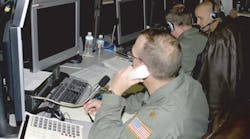The decrease hits all three services, but is less stringent for DOD-wide research
By John Rhea
WASHINGTON — Reflecting the ongoing military operations in Iraq, the science and technology portion of the U.S. Department of Defense budget request for fiscal year 2005, which begins Oct. 1, declined 13.2 percent, while the combined DOD and Department of Energy weapons budget is projected to increase from $401.3 billion this year to $450.5 billion.
Furthermore, White House budget director Joshua Bolten cautioned that the administration might seek an additional supplemental request of as much $50 billion to pay for operations in Iraq and Afghanistan after this year's election. This would be on top of the $2.4 trillion total 2005 federal budget submitted to Congress Feb. 2.
The key areas of the budget for industry participants are the science and technology programs designated 6.1 (basic research), 6.2 (applied research} and 6.3 (advanced technology development), and this is the area that is taking the hit.
The decline, from $12.1 billion this year to $10.5 billion in the new budget request, hits all three services, but is less stringent for DOD-wide science and technology efforts.
Army funding in all three categories would fall 31.1 percent from $2.6 billion to $1.8 billion; Navy funding across the board would drop 22.5 percent from $2.2 billion to $1.7 billion; and the Air Force would experience a decline of 17.3 percent from $2.3 billion to $1.9 billion, also dropping in all three categories.
A possible bright spot is defense-wide funding at the Defense Advanced Research Projects Agency (DARPA) and other elements, which would be up in two of the three categories for an overall increase of 4.3 percent from $4.9 billion to $5.1 billion.
DOD comptroller Dov Zakheim focused on the defense-wide programs in his annual budget briefing, saying that the science and technology programs "may not translate into actual military capability."
Instead, he said, "The National Aerospace Initiative, Hypersonic and Space Systems, the future combat system technologies, future naval capabilities, high-efficiency, lightweight power sources for our troops, and what the Joint Forces Command is doing, some emphasis in general, if you will, on nanotechnology, on computers, on sensors, on propulsion systems. This is our cutting edge and once again we've put more money into it."
In another perspective, officials at the American Institute of Physics in College Park, Md., which analyzes the science and technology segments of all government agencies, noted that the Defense Science Board had recommended that 3 percent of the defense budget be allocated to this category and that goal was later spelled out in the Quadrennial Defense Review issued in 2001. In fact, the science and technology category declined from 2.68 percent in this fiscal year to 2.61 percent in the new request.


